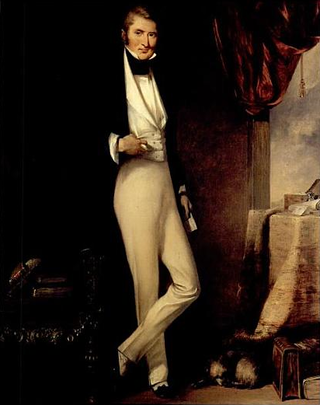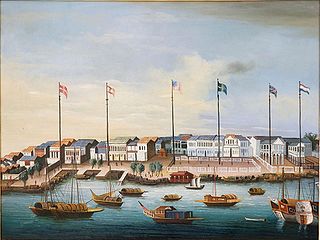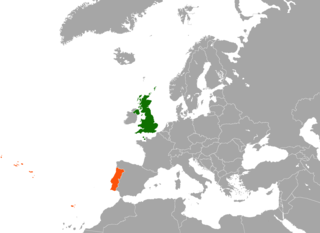History (late 18th century to 1831)
Starting in the mid to late eighteenth century, the British East India Company had a firm grasp on its opium monopoly. However, around the turn of the nineteenth century, the British supply, which came from its territories in Eastern India, specifically Bengal, was not sufficient to meet the demands of China, with whom the British traded most of their opium. [2] Other regions in India, such as Malwa, were able to account for this deficit in British opium production, thereby posing a threat to the British monopoly. [3]
Malwa opium was introduced into the opium trade with China possibly as early as 1770. At the start of the eighteenth century, up to 1000 crates of Malwa opium were shipped from Bombay and traded with China annually. [4] In an effort to maintain their monopoly, the Governor-General of the Company ordered the Bombay Presidency government to stop opium cultivation in the region and therefore to remove this competing opium from the market. This was done in 1803 but to little effect, since the opium shipped from Bombay was cultivated in Malwa, a region outside the control of the Bombay government. In addition to cultivation, it became illegal in 1805 to move and ship opium from British territories and ports in Western India. [5]
However, the Malwa opium trade persisted with increasing success. This was partly due to Malwa opium’s comparatively lower market price and the fact that Malwa had an established practice of opium cultivation since at least the sixteenth century. [6] However, the growth of the Bombay Malwa opium trade was due in large part to Indian efforts to circumvent the export restrictions placed on opium. Many Indian merchants and businesspeople had a vested interest in the Bombay opium market prior to British intervention, and in order to protect these interests a great number of traders began smuggling. Without access to Bombay ports, Bombay traders turned to indigenous groups and regional elites for alternative avenues. [7] After 1805, exporting out of Bombay became difficult, and many Bombay firms and merchants turned to smuggling Malwa opium through the Gujarat coast. [8]
The continued growth of the Malwa opium market and the export of Malwa opium forced the East India Company to switch strategies. In 1819, the British decided to involve themselves in Malwa opium and in Bombay opium auctions, hoping to become the sole supplier of Malwa opium. [9] The British struggled to form a monopoly over Malwa opium as they did with Bengal opium. Unlike the opium grown in Bengal directly under British control, the opium grown in Malwa remained under the authority of princely rulers and indirectly under the control of the British. [10] Lacking sufficient connections to directly procure opium from the Malwa market, the Company had to at first turn to private Bombay merchants and firms to facilitate transactions between Company buyers and Malwa producers of opium. [11] Once the British established relations with the various princely rulers in the region of Malwa, they endeavored to form treaties with the indigenously ruled states to regulate the sale of opium. [12] As part of these treaties, most of which were signed in 1926, the British fixed the price of sale. [13]
According to a February 1830 conversation recorded in the Journal of the House of Lords, the official minute book of the House of Lords of British Parliament, between the Lord President and John Walter Shreher, a British official deputed in Malwa, this fixed price was grossly short of what the private Bombay merchants and firms usually paid:
“[Lord President:] ‘Did he further stipulate to furnish any quantity of opium at a certain price to the Company?’
[John Walter Shreher:] ‘He did.’
‘Was that price much below the price at which it had been obtained by the Bombay Agents?’
‘Considerably.’
‘Can you state the difference?’
‘The Bombay Agent had paid from sixty-five to one hundred and odd Rupees for a Punsury, which is five Siers; a Punsury contains ten pounds English weight.’
‘What did you pay under the Treaty?’
‘Thirty Rupees.’” [14]
During these years (1805-1830) there were 121 indigenous opium trading firms/merchants in Bombay that were independent of the British, as opposed to only 25 non-indigenous firms in the region. [15] In 1831, the British, having found that complete control of the Malwa opium market remained elusive, partly owing to their unimpressive efforts to fix the price of sale, made private export of opium legal upon payment of a duty. [16]












